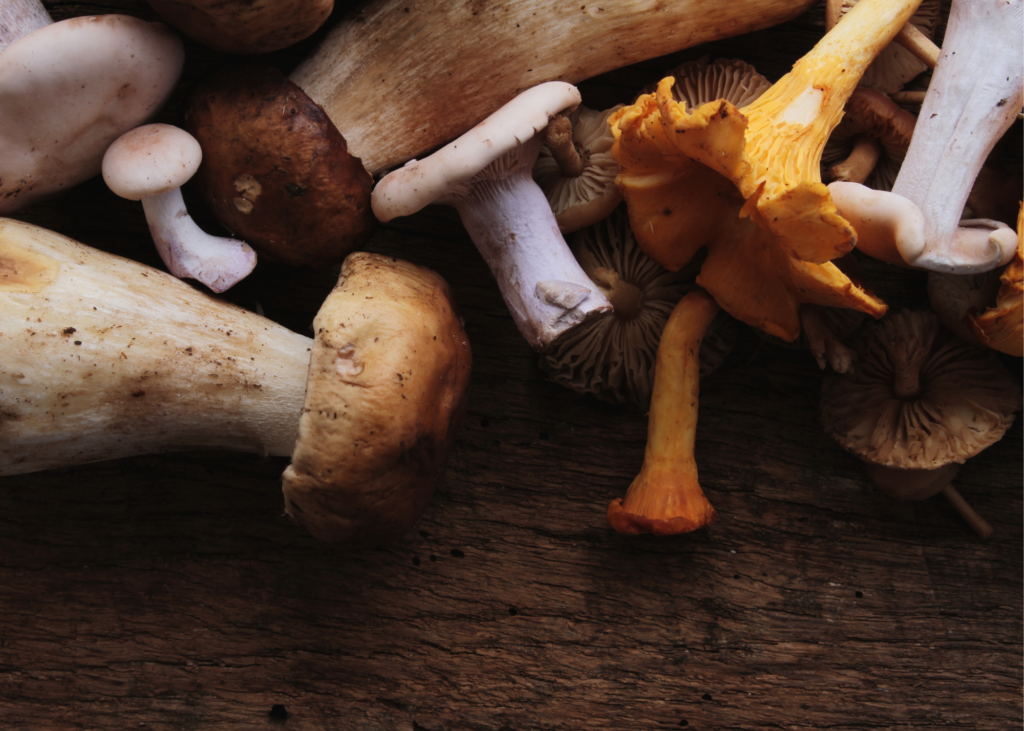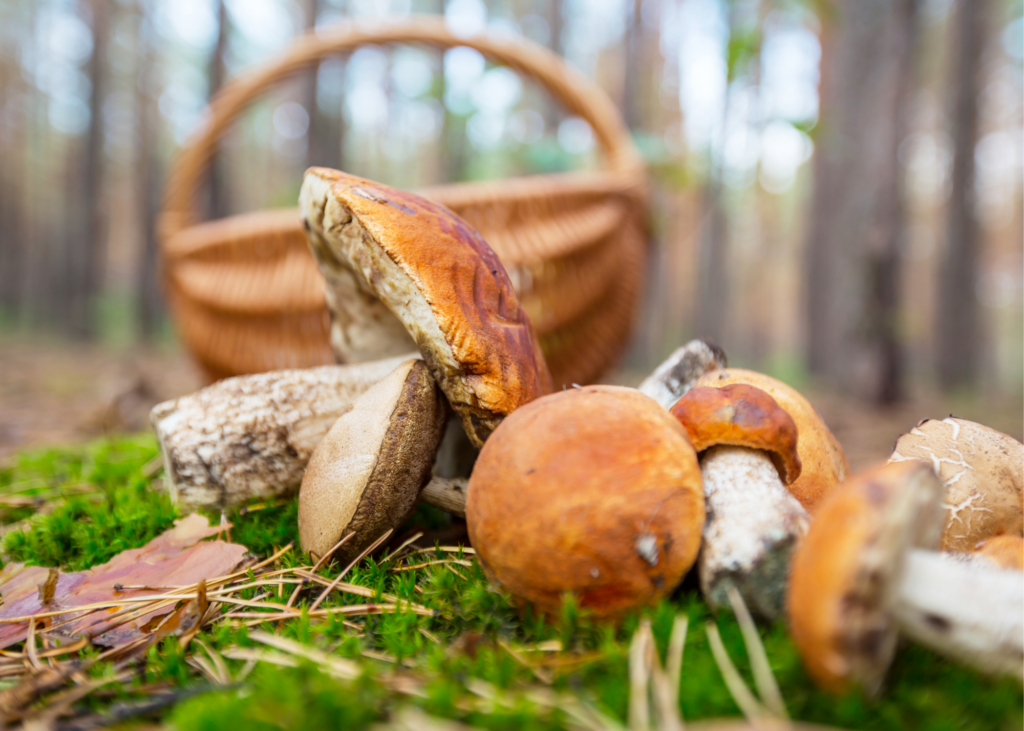By Wellness Manager Anne Fletcher, September 2021

What is a mushroom? “Mushroom” is the name most often given to the fruiting body of a fungus. But these organisms are much more than what meets the eye. In fact, most of the mushroom exists unseen in a network of mycelia, a web-like structure of threads that feeds the organism and is imbedded in its substrate, aka food source. The part we see as a mushroom- the fruiting body- is the reproductive structure that distributes spores that spread the organism. Not all fungi produce mushrooms, and those that do could be perennial- with the mushroom remaining and growing larger every year- or annual and reaching maturity the same season it started growing. Some mushrooms, such as chaga, are not even the fruiting body but rather a structure called a “sclerotium” where the fungus stores food sources (very important in the harsh Northern environments where this fungus grows). Knowing about the lifecycle of a fungus and how you impact it by harvesting the part you desire is essential to sustainable harvesting.
The field of mycology is vast, quickly evolving, and extraordinary. Fungus is believed to be the first form of multicellular life that emerged on land. Without soil, plants needed the presence of fungi to release essential minerals from stone so they could use them. Forest soil today is a complex array of mycelial networks that have symbiotic relationships with tree roots, feeding them minerals in exchange for sugars produced through photosynthesis. These symbiotic relationships are essential for forest health, carbon sequestration, biodiversity, and even timber production and are finally in the last few years starting to get the attention they deserve. In the lab, fungus is propagated by cloning parts of the mycelia and there are many emerging studies on the “intelligence” of the mycelia in making “decisions” and having “memory” in relation to food sources. I read a study once that “trained” a mycelia to find a food source through a maze, and subsequent propagations of that same mycelia were able to find the food more quickly because they “remembered” the path. Clearly there are still a colossal number of mysteries of the fungal kingdom- and some scientists believe that up to 97% of fungi are still undiscovered and undescribed in science.
Genetically, fungi and mushrooms have more in common with animals- and humans- than with plants. Hypothetically, this genetic relationship is why mushrooms can have such a profound impact on the human immune system- because some of the same compounds the fungus produces to protect itself from attack are used by the human body in a similar physiological way. So why aren’t medicinal mushrooms already a part of our diets that have been shaped by our more-in-tune ancestors? Different cultures could be considered mycophilic- with a history of culinary and medicinal use of mushrooms- such as Eastern European, Chinese, or much of indigenous North and Meso-American cultures; however, a dominating English and Irish history in New England might be considered the epitome of mycophobic- which fungi are looked upon with fear and loathing- and might explain why mushrooms have not been a particularly common part of food and medicine systems in this region for the last 400 years.
The historical and present-day traditional use of mushrooms as medicine has a lot to offer the modern world. Ponder these awesome discoveries:
- Some of the highest ORAC (a measure of antioxidant activity) foodstuffs studied are fungal.
- The Agarikon mushroom traditionally used by Pacific Northwest tribes has gotten so far as being classified a national treasure by our Department of Defense based on research showing its antiviral properties that could be useful against future bioweapons.
- Insects, including bees, are known to consume mushroom mycelia and it appears to have a medicinal effect on them, a promising solution to honeybee diseases including colony collapse disorder.
This is an exciting and emerging field in the west- but by far, the most widely utilized and researched fungi traditions today are from East Asia. Much of our current understanding about the therapeutic use of medicinal mushrooms comes out of generously funded research on Traditional Chinese Medicine. This research comes to us from a very different cultural lens, and thus lacks some of the controls (such as double-blind studies) deemed critical in Western allopathic medicine which leads to this research often being dismissed in the West. It is also important to acknowledge that collectivist ideals and national pride that inform medicinal research priorities in communist China produce predictably different outcomes in terms of who will benefit than our Western system firmly rooted in private enterprise and capitalism.

What makes a mushroom medicinal? There is population research showing health benefits for people eating any type of mushroom on most days versus those who never eat mushrooms. But the therapeutic value of some mushrooms is much greater than others, and in general, the mushrooms that have the higher medicinal value are those that grow on a wood substrate. That means that button, crimini, baby bella, and portobellos (which are all just different names and growth states of the same species and are grown on manure) do not have much medicinal value. Many mushrooms that grow on wood in the wild are cultivated on a variety of substrates such as straw or rice hulls; these mushrooms and their mycelia can still have great health benefits.
What kind of benefits are we talking about here? Medicinal mushrooms are best known for their immune system effects that can include providing enhanced immune function where needed (in cases of pathogenic invasion or internal cellular disfunction such as a deformed cell). Different mushrooms are often associated with immune-modulating functions specific to different areas of the body. Beyond the immune system effects, different species are associated with improved neurological and nervous system function, cardiovascular function, adaptogenic (stress protecting) effects, and so much more. There is a mushroom for everyone!
In this time of ecological collapse and complicated health struggles, mushrooms have an important role to play in our personal and global health and resilience. If you want to learn more about which mushroom or mushrooms might be best to incorporate into your diet or health regimen, my next post will explore how to prepare and specific uses of different species.

Comments are closed.